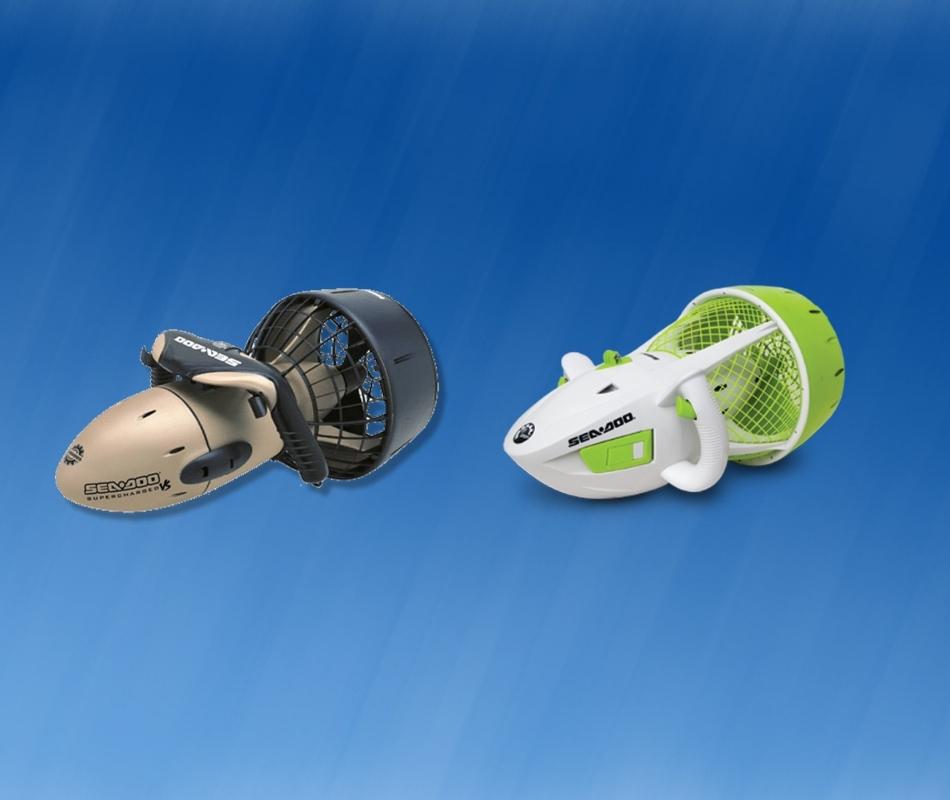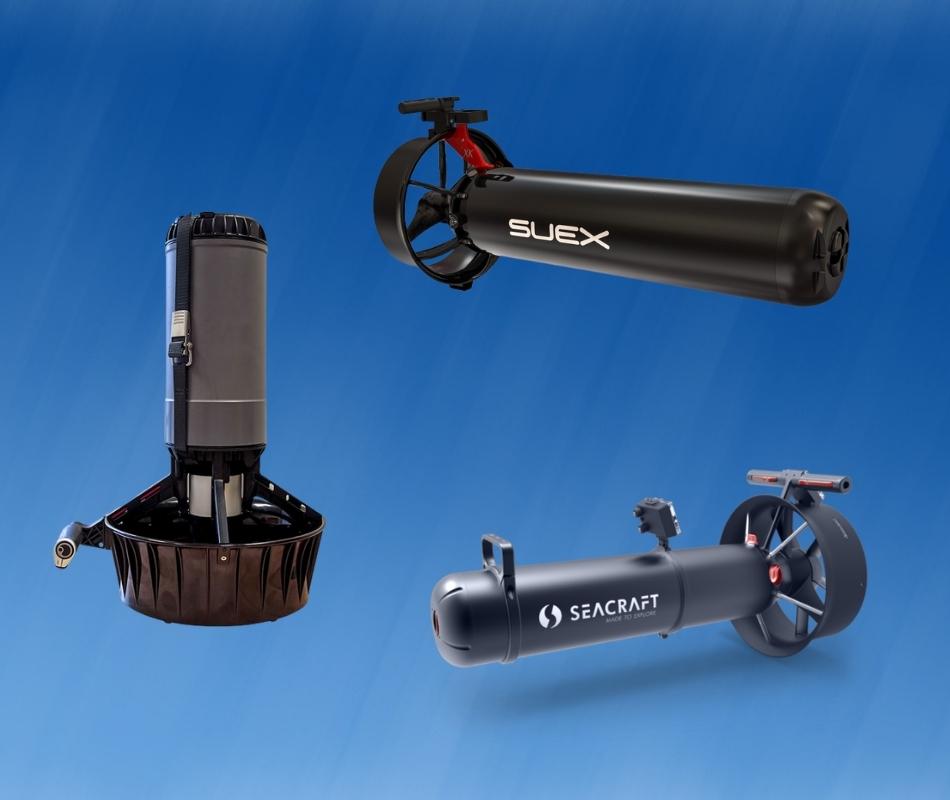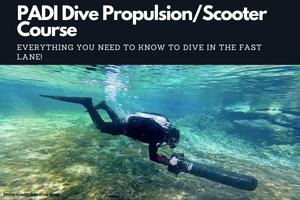Have you ever wanted to see more while on a dive but are limited by how much you can swim? Have you ever wanted to get to a wreck but don’t have access to a boat? Have you ever seen an action film with a group of navy seals leaving a submarine in shallow water and zipping away, being towed by some cool-looking torpedos? If you have asked yourself any of those questions or had those thoughts about Dive propulsion vehicles, maybe taking the Dive propulsion Course is something you want to consider. Hopefully, this article will answer any questions or doubts about why take the course and get you into the fast lane of diving.
What is involved in the PADI Dive propulsion course
The PADI dive propulsion course emphasizes diving, so the knowledge portion is relatively short. All required is to review the short course manual and watch the provided video online, which repeats most of what is in the manual.
Then you will have two fun open water dives where your instructor will show you some of the safety skills and how to maintain the DPV/scooter and how to drive it around are just some of the things you will learn in this course.

Who should take the Diver propulsion Vehicle/scooter course?
The dive propulsion course has no prerequisite outside of the standard dive equipment, and if you own your equipment, the instructor will provide the Dive propulsion vehicle/scooter. So this course is perfect for anyone looking to extend their range and have some of the most fun someone can have in the water.
What the course will cover
- The dive propulsion course has seven sections they will cover.
- why use a DPV
- DPV overview and selection
- DPV setup maintenance, battery care and transportation
- Dive planning consideration
- Handling DPV- step by step
- Diver propulsion s vehicle specialty course open water dive
- Knowledge review I and II
The course will break down the different models of scooters available, everything from the very cheap recreational versions, which are pretty slow with short battery life. To a premium recreational scooter with a good battery life of 1-2 hours with a much faster speed than you could swim. Models that work off standard Dewalt electric drill batteries are available, making it more affordable to have spare batteries. Finally, the Rockets in the industry are the technical dive propulsion vehicles or scooters. They are speedy. Some are over 300ft a min with 3-5 hour run times and a 300ft+ depth rating. Some dive computers have several accessories that you can get with them, such as a digital console that will display battery life left, depth, underwater GPS marking and speed. These features can come with a hefty price tag, but they add fun information.


Dive propulsion vehicle Maintenance will be specific to the models you use the day of the course. You will be shown how to maintain the O rings and prop barring and how to maintain the scooter’s battery life. Some technical scooters will be able to detach the propeller or switch it underwater.
The dive portion of the DPV course explains how the DPV should toe you properly, as you should not be hanging on for dear life when riding your scooter. The leash that attached you to the vehicle should be short enough so that your arms aren’t extending when the vehicle is in action. Your arms should be relaxed and free to move at all times. They will enable you to steer the scooter and not the scooter steering you. If you hang on to the scooter as it tows you, it will be challenging to drive the vehicle, and your arm will get tired while scootering, which could lead to an unsafe condition. You will be shown how to set up the scooter’s leash and balance a new scooter so it rides trim in the water.
Open water dives with the scooter.
Like so many PADI courses, the open water portion of the course is the best part as they usually are a lot of fun, and the scooter course does not disappoint.
You will get be given time in shallow water to set up your leash and get comfortable being towed by the scooter. This will help you learn how to make wide banking turns very similar to a plane gliding and how to make steep aggressive turns which is a lot of fun to feel all your equipment shift in the water and the fish getting out of your way.
Once you get comfortable scootering around your instructor will normally demonstrate a few important skills for a DPV operator such as; how to tow a dive buddy, air sharing situations while towing a dive buddy very valuable skills, and how to communicate to your dive buddy while being towed, because when you’re zipping through the water it’s normally hard to keep track of your buddy when they are out of sight. Some of the other skills you will be shown and will demonstrate are how to stop a runaway scooter, which can be a scary situation underwater, getting thrown about by a scooter that won’t stop, and finally, how you would untangle your prop underwater.
All these skills are demonstrated and practiced in a very casual atmosphere. There isn’t a set number of dives, but you usually get to just enjoy the scooter in a shallow, safe environment for the better part of a day or afternoon.
How to take the PADI Dive Propulsion/ scootering course.
Because the DPV course doesn’t have along of book work to do, it is an excellent course to be done in conjunction with other classes, like the advance open water course would be a good one to add. I did my DPV course over a week-long training program I did through Dans Dive Shop. The week-long training involved an Intro to technical course, then a Cavern diving course and finally, after a week-long intense training, we finished with a very relaxing PADI Dive Propulsion course.
I did all three courses in the Florida Panhandle area, where various springs are available for cavern and cave diving. My DPV course was held at Ginnie springs. If you are not familiar, crystal clear water is comfortable to swim in with plenty of things to see. It was the best possible setting and ending to a fun yet challenging week of dive training. The scooter course is an excellent complement to the Intro to tech and cavern course because my goals are to extend my range as a technical diver if I can dive deeper and in caverns or cave diving ( I am not cave trained Yet!) having a scooter allowed you to see more and potentially get you out of a cave faster if the need arose.
Cost of the course
The PADI Dive Propulsion Vehicle course costs $225 (2016 prices), including the course manual and crew pack. There wasn’t any extra equipment I needed to buy for the course as the instructor provided the scooter harness and leash.
As you can see, the PADI Dive Propulsion Vehicle course is full of good information, and it’s presented in a fun and informative environment with very little classroom time, the course manual is relatively short. Because of the ease of the course and the door, it opens to having some of the most fun in the water,r that I feel if you have the opportunity to take this course or just take a scooter out for a spin because it will quickly be added to your list of underwater need to do’s!

